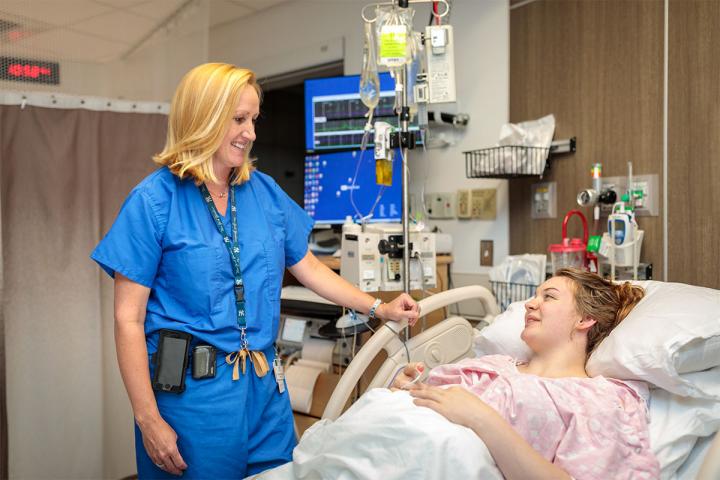
Credit: Matt Miller/Washington University
More than 3 million women in the United States give birth each year. But obstetricians have differing opinions about when women should begin pushing during labor and whether the timing of pushing increases the likelihood of a cesarean section, which carries a higher risk of complications compared with a vaginal delivery.
Many obstetricians recommend that a woman begin pushing as soon the cervix is fully dilated, while others advise waiting until she feels the urge to push. Until now, doctors have not had conclusive evidence about which approach is better for mothers and their babies.
Now, a multicenter study led by Washington University School of Medicine in St. Louis and involving more than 2,400 first-time pregnant women, shows that the timing of pushing has no effect on whether women deliver vaginally or by C-section.
However, women who delayed pushing experienced longer labors and higher risks of severe postpartum bleeding and infections. Their babies also were more likely to develop sepsis – a serious complication related to infection.
The study, funded by the National Institutes of Health (NIH), is published Oct. 9 in the Journal of the American Medical Association.
"Obstetricians tend to favor one approach over the other, but no solid evidence has existed to favor either one," said the study's first author, Alison G. Cahill, MD, a Washington University associate professor of obstetrics and gynecology and director of the Division of Maternal-Fetal Medicine. "We think our findings are likely to change how many obstetric providers manage labor. Previous studies comparing the immediate versus pushing approaches involved small numbers of patients, and results were often contradictory and inconclusive."
The current study enrolled 2,414 first-time pregnant women at one of six U.S. hospitals between May 2014 and November 2017. The women were at least 37 weeks pregnant with a single pregnancy, and all had received epidural anesthesia to reduce labor pain. Once the cervix was fully dilated at 10 centimeters, indicating the beginning of the second stage of labor, the women were randomly assigned to either begin pushing immediately or to delay pushing for 60 minutes.
Of those in the immediate-pushing group, 1,031 (85.9 percent) delivered vaginally compared with 1,041 (86.5 percent) in the delayed-pushing group – a difference that is not statistically significant.
"The findings provide strong evidence that for first-time pregnant women receiving epidurals, immediate versus delayed pushing during the second stage of labor did not affect vaginal delivery rates," said Menachem Miodovnik, MD, a medical officer at the NIH's Eunice Kennedy Shriver National Institute of Child Health and Human Development.
However, women in the immediate-pushing group experienced significantly lower rates of infections and fewer episodes of excessive bleeding following delivery. Specifically, 80 (6.7 percent) of the women who began pushing immediately developed an infection compared with 110 women (9.1 percent) who delayed pushing. In addition, 27 (2.3 percent) in the immediate-pushing group suffered severe postpartum bleeding, compared with 48 (4 percent) in the delayed-pushing group.
Additionally, women who pushed immediately experienced a shorter second-stage of labor by an average of 30 minutes, compared with those who delayed pushing — 102.4 versus 134.2 minutes.
Although the numbers were small, infants delivered to mothers in the immediate-pushing group experienced significantly lower rates of suspected sepsis compared with those in the delayed-pushing group: 38 (3.2 percent) and 53 (4.4 percent), respectively.
"Pushing during labor is physically demanding and intense," said Cahill, who delivers babies at Barnes-Jewish Hospital. "Women look to their obstetric providers for guidance and what's best for them and their babies. Our findings can guide providers to better manage the second stage of labor for optimal health for moms and their babies. This means avoiding delayed pushing for the sake of increasing the chance of vaginal delivery since it is associated with longer labor time and higher health risks to mothers and babies."
###
Media Contact
Diane Duke Williams
[email protected]
314-286-0111
@WUSTLnews
Original Source
https://medicine.wustl.edu/?p=66195&preview=1&_ppp=ee4fe603d4





